Mindfulness meditation techniques offer effective solutions for stress relief and emotional balance. These practices enhance self-awareness and promote relaxation through focused breathing and body scans. Regular mindfulness can lower cortisol levels and improve emotional regulation, fostering resilience against stressors. Beginners can easily adopt techniques like body scan and loving-kindness meditation to enhance their overall well-being.
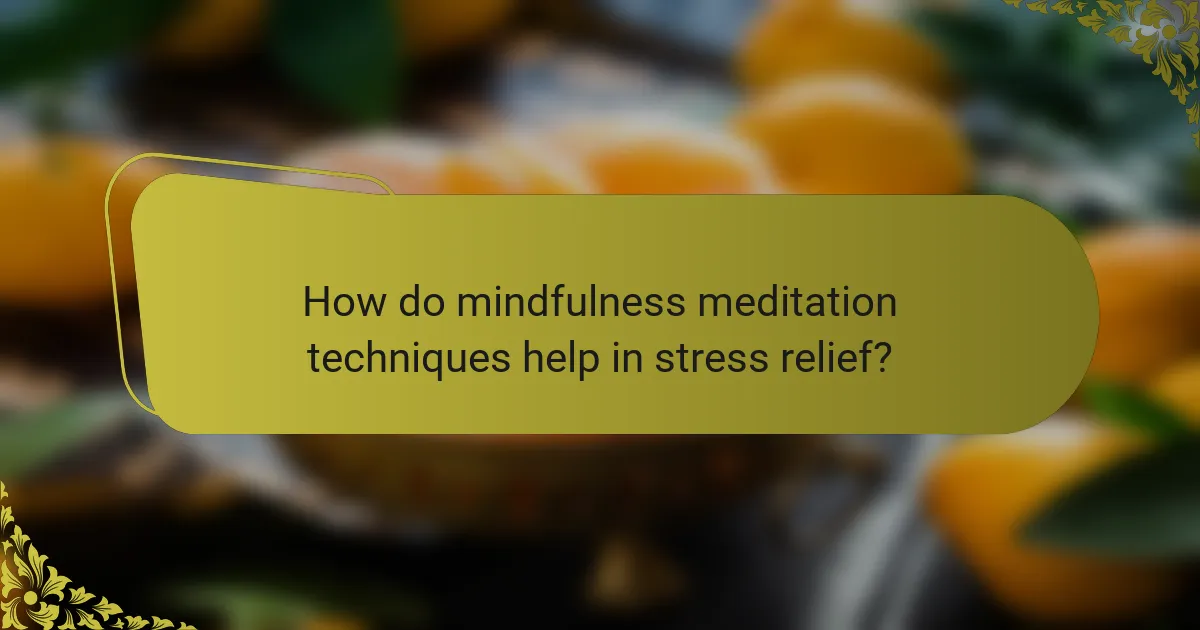
How do mindfulness meditation techniques help in stress relief?
Mindfulness meditation techniques significantly reduce stress and promote emotional balance. These practices enhance self-awareness and foster a sense of calm, enabling individuals to manage stress more effectively.
Mindfulness techniques, such as focused breathing and body scans, help individuals observe their thoughts without judgment. This observation reduces anxiety and cultivates a more positive mindset. Research indicates that regular mindfulness practice can lower cortisol levels, the hormone associated with stress.
Additionally, mindfulness meditation encourages emotional regulation. Practitioners learn to respond to stressors with greater resilience, reducing impulsive reactions. This emotional balance contributes to improved mental health and well-being.
In summary, mindfulness meditation techniques offer practical tools for stress relief, enhancing emotional stability and overall quality of life.
What are the physiological effects of mindfulness meditation on stress?
Mindfulness meditation significantly reduces stress by promoting relaxation and enhancing emotional regulation. Research indicates that regular practice can lower cortisol levels, the hormone associated with stress. Additionally, mindfulness meditation improves focus and fosters a sense of presence, which helps individuals manage stressors more effectively. Participants often report increased resilience and a greater ability to cope with challenging situations, leading to long-term emotional balance.
Which mindfulness meditation techniques are most effective for reducing anxiety?
Mindfulness meditation techniques such as body scan, loving-kindness, and breath awareness are effective for reducing anxiety. These practices encourage present-moment awareness, promote relaxation, and enhance emotional regulation.
Body scan meditation involves systematically focusing on different body parts, releasing tension, and fostering a sense of calm. Loving-kindness meditation cultivates compassion towards oneself and others, which can alleviate feelings of anxiety and isolation. Breath awareness centers attention on the breath, helping to anchor thoughts and reduce stress.
Research indicates that regular practice of these techniques can lead to significant reductions in anxiety levels. For instance, a study found that participants practicing mindfulness meditation showed a 30% decrease in anxiety symptoms after eight weeks.
How does mindfulness meditation influence emotional regulation?
Mindfulness meditation significantly enhances emotional regulation by fostering awareness and acceptance of emotions. Practicing mindfulness helps individuals observe their feelings without judgment, leading to reduced reactivity and improved coping strategies. Research indicates that regular mindfulness meditation can decrease symptoms of anxiety and depression, promoting a more balanced emotional state. This technique cultivates resilience, enabling individuals to respond to stressors with greater clarity and calmness.
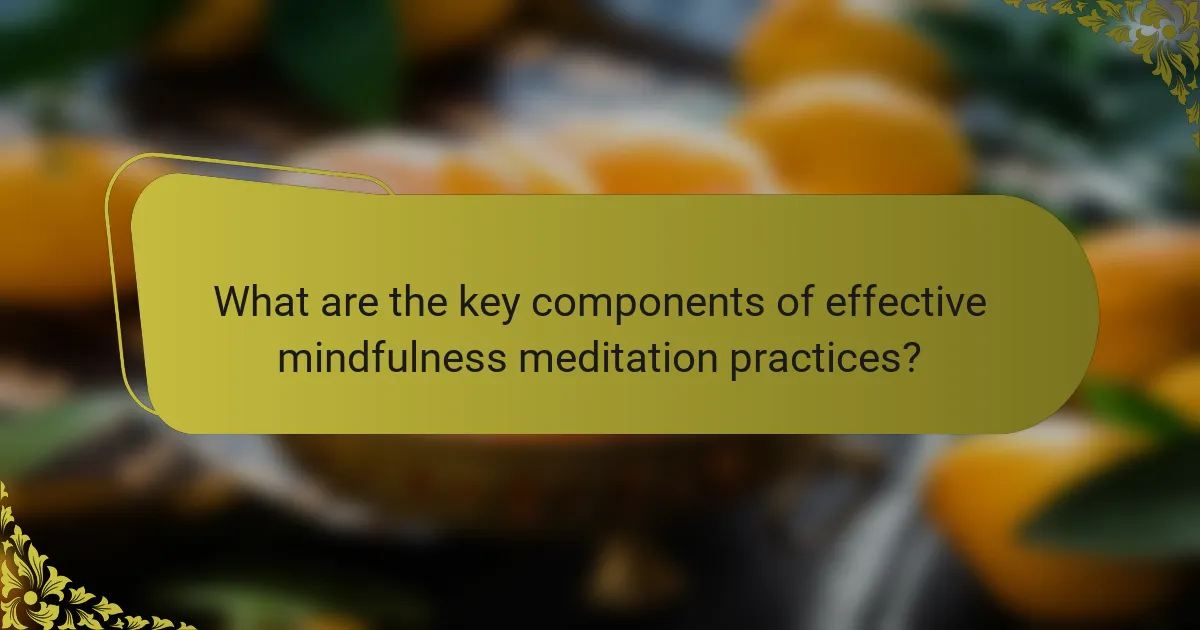
What are the key components of effective mindfulness meditation practices?
Effective mindfulness meditation practices include focused attention, breath awareness, and body scanning. These components enhance stress relief and emotional balance through increased self-awareness and relaxation.
Focused attention involves concentrating on a single object or thought, which helps reduce distractions. Breath awareness centers on observing the breath, fostering a calming effect. Body scanning encourages awareness of physical sensations, promoting relaxation and grounding.
Incorporating these techniques into daily routines can significantly improve mental clarity and emotional stability. Regular practice can lead to lasting benefits, such as reduced anxiety and improved overall well-being.
How does breath awareness enhance mindfulness meditation?
Breath awareness significantly enhances mindfulness meditation by anchoring attention and promoting relaxation. This technique allows individuals to focus on their breath, creating a sense of presence and reducing stress. By observing the breath, practitioners can cultivate emotional balance, as it fosters a non-judgmental awareness of thoughts and feelings. This practice encourages a deeper connection to the present moment, facilitating a more profound meditative experience. Additionally, studies show that breath awareness can lower anxiety levels and improve overall mental well-being, making it a valuable component of mindfulness meditation.
What role does body scanning play in mindfulness techniques?
Body scanning enhances mindfulness techniques by promoting awareness of physical sensations and emotional states. This practice encourages individuals to focus on their bodies, fostering a deeper connection to the present moment. It can reduce stress and improve emotional balance by identifying areas of tension and discomfort. As a result, body scanning cultivates relaxation and mindfulness, making it a valuable tool in stress relief practices.
Which visualization techniques are beneficial in mindfulness meditation?
Visualization techniques beneficial in mindfulness meditation include guided imagery, body scans, and mindful breathing. These methods enhance focus, reduce stress, and promote emotional balance. Guided imagery allows individuals to visualize calming scenes, fostering relaxation. Body scans help increase awareness of physical sensations, encouraging acceptance. Mindful breathing centers attention on the breath, grounding practitioners in the present moment.
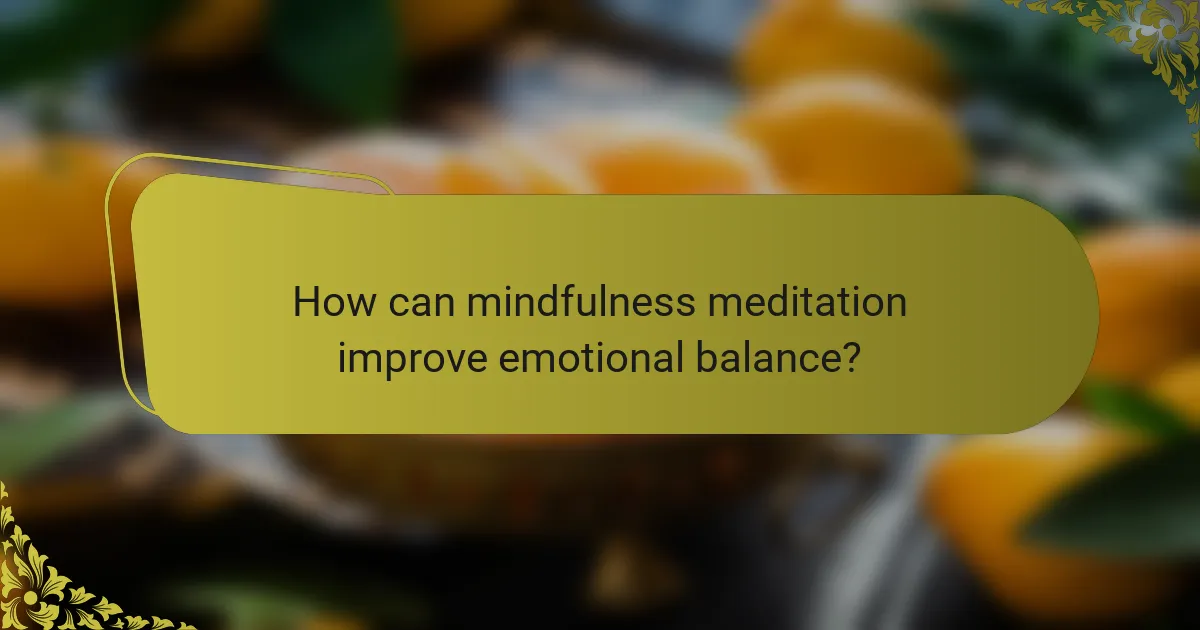
How can mindfulness meditation improve emotional balance?
Mindfulness meditation significantly enhances emotional balance by promoting awareness and acceptance of thoughts and feelings. This practice reduces stress and anxiety, leading to improved emotional regulation. Regular mindfulness meditation can help individuals develop resilience, fostering a more stable emotional state over time. Research indicates that consistent practice can lower cortisol levels, contributing to a calmer mind.
What are the long-term emotional benefits of regular mindfulness practice?
Regular mindfulness practice leads to long-term emotional benefits such as improved emotional regulation, increased resilience, and enhanced well-being. Practitioners often report reduced anxiety and depression levels. Studies show that mindfulness can strengthen the brain’s emotional centers, promoting a more balanced emotional response. Additionally, regular engagement in mindfulness can foster greater self-awareness, allowing individuals to better understand and manage their feelings over time.
How does mindfulness meditation foster resilience against emotional disturbances?
Mindfulness meditation enhances resilience against emotional disturbances by promoting self-awareness and emotional regulation. This practice encourages individuals to observe their thoughts and feelings without judgment, fostering a sense of control. Regular engagement in mindfulness techniques can reduce stress and anxiety, leading to improved emotional balance. Studies show that participants in mindfulness programs report lower levels of emotional reactivity, suggesting a unique attribute of mindfulness meditation is its ability to cultivate emotional resilience over time. As a result, individuals become better equipped to handle life’s challenges, maintaining a more stable emotional state.
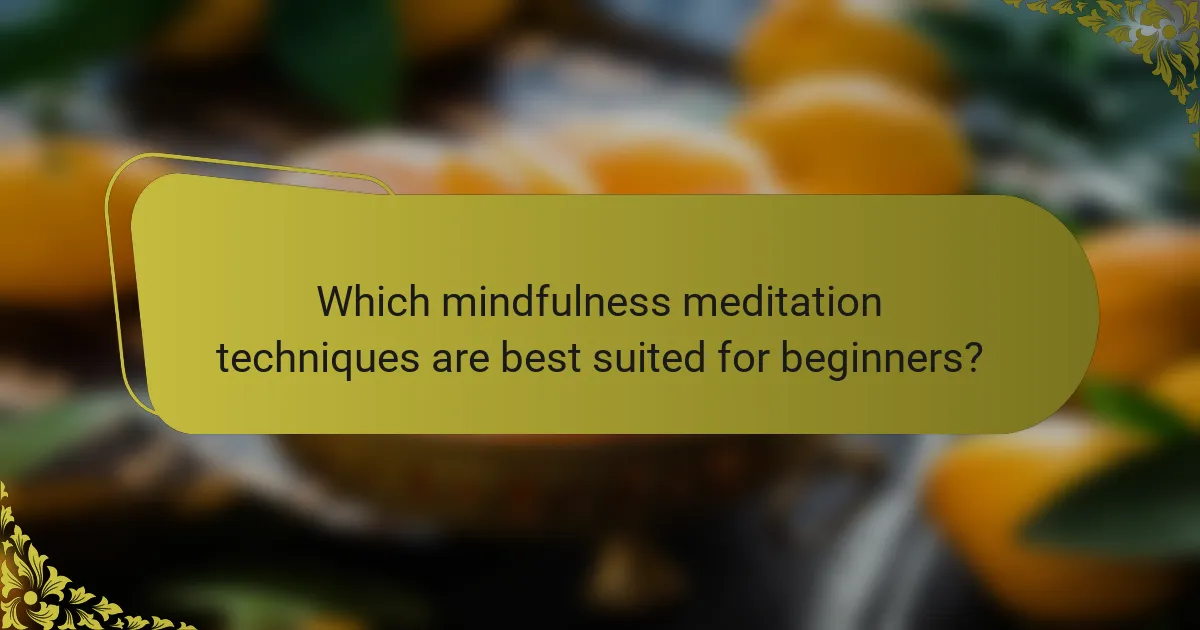
Which mindfulness meditation techniques are best suited for beginners?
Mindfulness meditation techniques best suited for beginners include body scan, mindful breathing, and loving-kindness meditation. These methods promote stress relief and emotional balance effectively.
Body scan meditation involves focusing attention on different body parts, helping to cultivate awareness and relaxation. Mindful breathing emphasizes awareness of breath, grounding individuals in the present moment. Loving-kindness meditation encourages positive feelings towards oneself and others, fostering emotional balance and compassion.
These techniques provide accessible entry points for beginners, enhancing their mindfulness practice and improving overall well-being.
What are some simple mindfulness exercises to start with?
Mindfulness exercises can effectively promote stress relief and emotional balance. Start with these simple techniques:
1. **Breathing Awareness**: Focus on your breath for five minutes, noticing each inhale and exhale.
2. **Body Scan**: Lie down and mentally scan your body from head to toe, acknowledging any tension.
3. **Mindful Walking**: Take a slow walk, paying attention to the sensations of your feet touching the ground.
4. **Gratitude Journaling**: Write down three things you are grateful for each day to foster positive emotions.
5. **Five Senses Exercise**: Identify five things you can see, four you can touch, three you can hear, two you can smell, and one you can taste.
These exercises can be done anywhere and require minimal time, making them accessible for daily practice.
How can beginners maintain consistency in their practice?
Beginners can maintain consistency in mindfulness meditation by establishing a routine, setting realistic goals, and creating a supportive environment. Regular practice, even for short durations, enhances emotional balance and stress relief.
1. Set a specific time daily for meditation.
2. Start with short sessions, gradually increasing duration.
3. Use guided meditations or apps for structure.
4. Keep a journal to track progress and reflect on experiences.
5. Join a meditation group for community support.
6. Be patient and kind to yourself, acknowledging that consistency takes time.
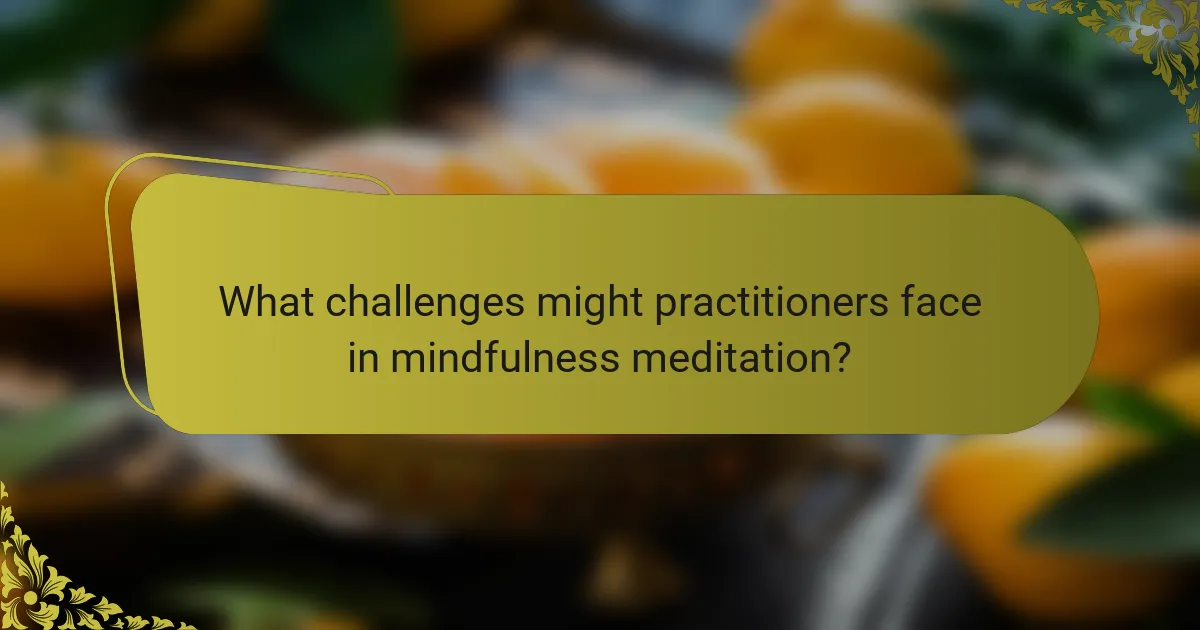
What challenges might practitioners face in mindfulness meditation?
Practitioners of mindfulness meditation may face challenges such as difficulty maintaining focus, managing intrusive thoughts, and experiencing emotional discomfort. These obstacles can hinder the effectiveness of techniques aimed at stress relief and emotional balance. Additionally, practitioners might struggle with consistency in their practice, leading to less noticeable benefits over time. Understanding these challenges is crucial for developing strategies to enhance mindfulness meditation experiences.
How can distractions be managed during meditation sessions?
To manage distractions during meditation sessions, establish a dedicated space and time for practice. Focus on your breath and gently redirect your attention when distractions arise. Incorporating mindfulness techniques enhances emotional balance and reduces stress. Practicing regularly strengthens your ability to maintain focus, creating a more profound meditation experience.
What common misconceptions exist about mindfulness meditation?
Common misconceptions about mindfulness meditation include the belief that it requires emptying the mind, that it is only for relaxation, and that it is a quick fix for emotional issues. Many think mindfulness meditation is solely about achieving a state of calm, while in reality, it involves awareness of thoughts and feelings without judgment. Some believe it is ineffective unless practiced for long periods, but even short sessions can provide benefits. Additionally, people often assume that mindfulness is a one-size-fits-all solution, overlooking the need for tailored approaches based on individual needs and experiences.
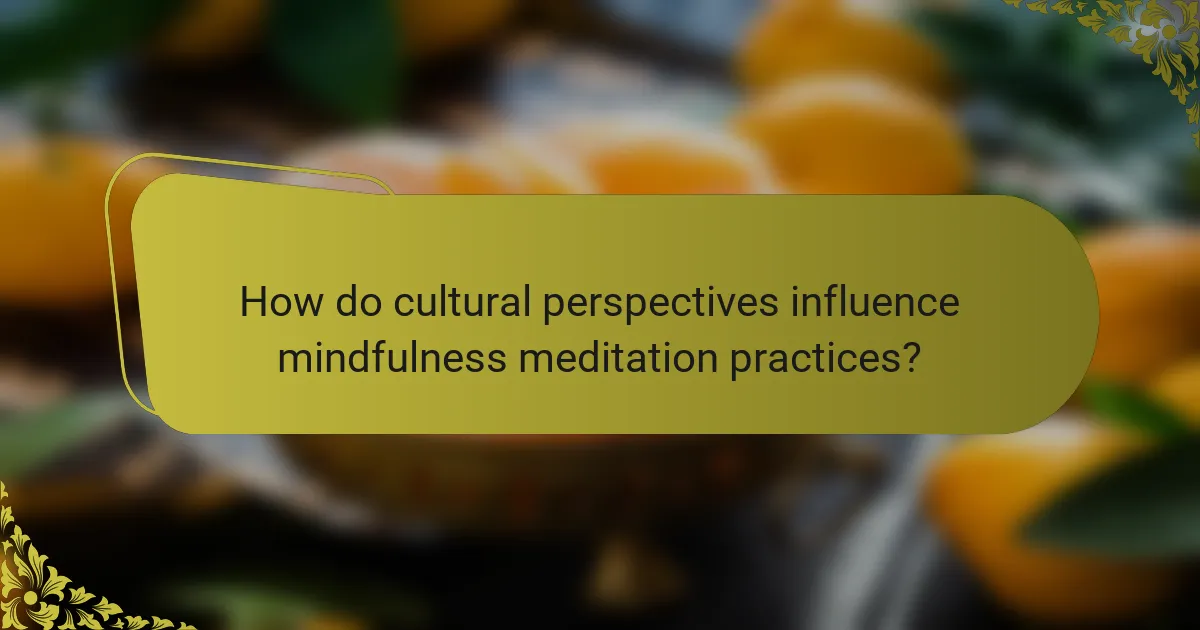
How do cultural perspectives influence mindfulness meditation practices?
Cultural perspectives significantly shape mindfulness meditation practices by influencing techniques, goals, and interpretations. For instance, Eastern traditions often emphasize spiritual growth, while Western adaptations focus on stress relief. These differences affect how practitioners engage with mindfulness, potentially enhancing emotional balance and stress management. Cultural context also determines the integration of community support and individual practices, impacting overall effectiveness. Adapting mindfulness techniques to fit cultural values can enhance acceptance and results, making the practice more relevant to diverse populations.
What are the differences in mindfulness meditation approaches across various cultures?
Mindfulness meditation approaches vary significantly across cultures, each emphasizing unique techniques and philosophies. For example, Zen meditation from Japan focuses on breath awareness and sitting in silence, while Vipassana from Southeast Asia emphasizes insight through observing bodily sensations. Tibetan Buddhism incorporates visualization and chanting, adding a spiritual dimension. Native American practices often include nature immersion and community rituals, promoting connectedness. Each approach offers distinct pathways for stress relief and emotional balance, reflecting cultural values and historical contexts.
How does the perception of mindfulness vary in different regions?
The perception of mindfulness varies significantly across regions due to cultural, social, and historical influences. In Western societies, mindfulness often emphasizes individual stress relief and emotional balance, focusing on personal well-being. Conversely, in Eastern cultures, mindfulness is deeply rooted in spiritual practices and community well-being, often integrating concepts of interconnectedness and harmony.
In North America, mindfulness is frequently associated with therapeutic practices, such as mindfulness-based stress reduction (MBSR), which highlights its psychological benefits. In contrast, Asian countries like Japan and India view mindfulness as part of broader spiritual traditions, emphasizing meditation’s role in achieving enlightenment and inner peace.
The accessibility of mindfulness practices also differs. Urban areas in developed regions may offer numerous resources, while rural areas in developing countries might have limited access to formal mindfulness training. This disparity influences how mindfulness is perceived and practiced, affecting its integration into daily life.
Moreover, the unique attributes of mindfulness practices can be observed in various regions. For instance, Tibetan Buddhism incorporates specific visualization techniques, while Zen Buddhism emphasizes the practice of sitting meditation (zazen). These regional differences enrich the global landscape of mindfulness, showcasing its adaptability and relevance across diverse cultures.
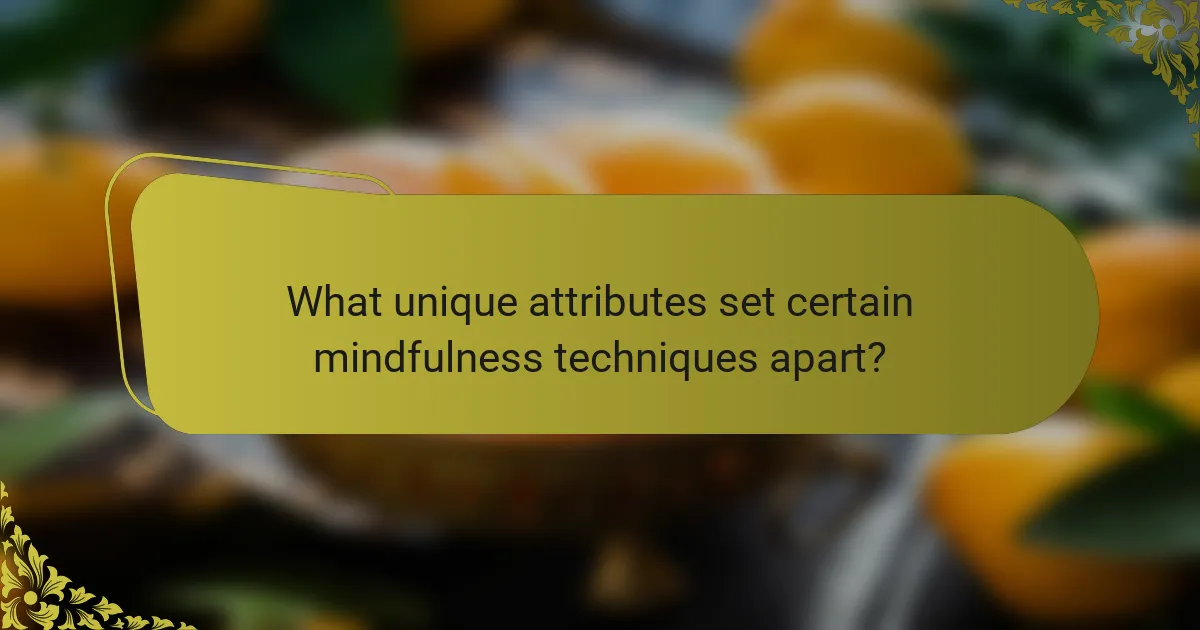
What unique attributes set certain mindfulness techniques apart?
Certain mindfulness techniques stand out due to their unique attributes, such as specific focus areas, methods of practice, and intended outcomes. For instance, body scan meditation emphasizes physical awareness, while loving-kindness meditation fosters emotional connection and compassion. These distinct approaches cater to various needs, enhancing stress relief and emotional balance through tailored experiences. Additionally, some techniques integrate movement, like mindful walking, which differentiates them from traditional seated practices. This variety allows individuals to choose techniques that resonate with their personal preferences and emotional states.
How do specific mindfulness practices cater to individual emotional needs?
Mindfulness practices address individual emotional needs by offering tailored techniques that promote stress relief and emotional balance. Techniques such as body scans enhance self-awareness, while loving-kindness meditation fosters compassion and reduces anxiety. Breathing exercises help regulate emotions, creating a sense of calm.
Different individuals may respond uniquely to these practices. For example, someone dealing with anxiety may benefit more from focused breathing, while another person seeking emotional balance might find body scans more effective. The flexibility of mindfulness techniques allows for personalized approaches, catering to diverse emotional states.
Research shows that consistent practice can lead to significant improvements in emotional regulation and stress management. A study found that participants practicing mindfulness reported a 30% decrease in stress levels after eight weeks. This highlights the effectiveness of mindfulness in addressing specific emotional needs.
In summary, mindfulness meditation techniques adapt to individual emotional requirements through various methods, promoting overall well-being and resilience against stress.
What rare mindfulness meditation techniques are gaining popularity in modern wellness?
Rare mindfulness meditation techniques gaining popularity include sound healing, forest bathing, and breathwork. These practices enhance emotional balance and stress relief through unique approaches.
Sound healing utilizes vibrations from instruments to promote relaxation. Forest bathing, or shinrin-yoku, immerses individuals in nature, fostering mindfulness and reducing anxiety. Breathwork focuses on controlled breathing patterns, enhancing emotional regulation and awareness.
These techniques, while not mainstream, offer valuable alternatives for those seeking deeper mindfulness experiences.
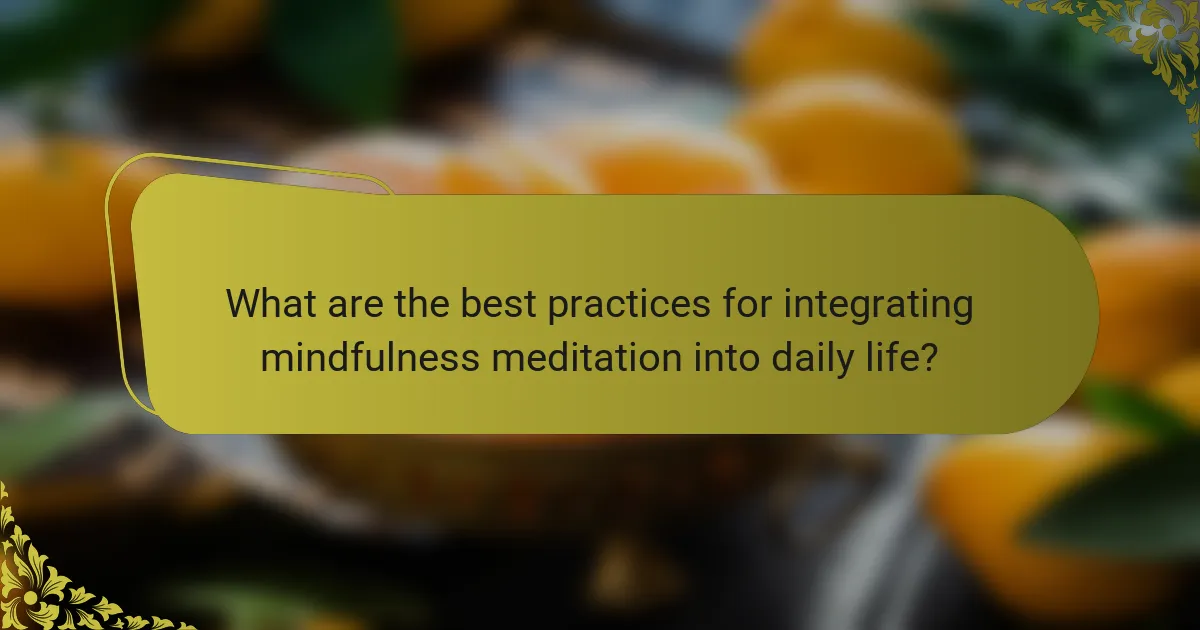
What are the best practices for integrating mindfulness meditation into daily life?
Integrating mindfulness meditation into daily life enhances stress relief and emotional balance. Establish a consistent practice by setting aside dedicated time each day.
1. Start with short sessions, gradually increasing duration as comfort grows.
2. Incorporate mindfulness into daily activities, such as eating or walking.
3. Use guided meditations or apps for structure and support.
4. Create a calming environment to enhance focus and relaxation.
5. Reflect on your experiences through journaling to deepen insights.
6. Engage with a community or group for motivation and shared learning.
How can mindfulness meditation be adapted for workplace stress relief?
Mindfulness meditation can effectively reduce workplace stress through various tailored techniques. Incorporating short sessions throughout the day can enhance focus and emotional balance.
1. **Breathing Exercises**: Encourage employees to practice deep breathing for a few minutes to alleviate tension.
2. **Guided Meditations**: Use audio or video resources that focus on stress relief, providing a structured approach.
3. **Mindful Breaks**: Implement scheduled breaks for mindfulness practices, allowing employees to reset their mental state.
4. **Group Sessions**: Organize regular group meditation sessions to foster community and shared experiences.
5. **Nature Engagement**: Promote outdoor mindfulness activities, utilizing natural settings to enhance relaxation.
These adaptations create a supportive environment that fosters well-being and productivity.
What tips do experts recommend for maximizing the benefits of mindfulness meditation?
To maximize the benefits of mindfulness meditation, experts recommend establishing a consistent practice, focusing on the breath, and cultivating a non-judgmental awareness. Setting aside dedicated time daily enhances emotional balance and stress relief. Additionally, utilizing guided meditations can provide structure, while integrating mindfulness into daily activities fosters continuous awareness. Practicing gratitude and self-compassion further enriches the experience, promoting overall well-being.
What common mistakes should be avoided when practicing mindfulness meditation?
To practice mindfulness meditation effectively, avoid common mistakes that hinder progress. Focusing on the breath, being present, and releasing judgment are essential.
Firstly, many practitioners struggle with expectations. They anticipate immediate results or profound experiences, which can lead to frustration. Instead, approach meditation with an open mind and patience.
Another common mistake is trying to eliminate thoughts entirely. Instead of forcing a blank mind, acknowledge thoughts as they arise and gently return focus to the breath.
Additionally, skipping regular practice can impede benefits. Consistency is vital for developing mindfulness skills over time. Aim for short daily sessions rather than infrequent longer ones.
Lastly, neglecting the body can detract from the experience. Maintain a comfortable posture to enhance focus and prevent discomfort during meditation.
